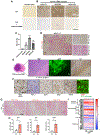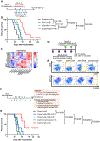Modification of Extracellular Matrix Enhances Oncolytic Adenovirus Immunotherapy in Glioblastoma
- PMID: 33257429
- PMCID: PMC7854507
- DOI: 10.1158/1078-0432.CCR-20-2400
Modification of Extracellular Matrix Enhances Oncolytic Adenovirus Immunotherapy in Glioblastoma
Abstract
Purpose: Extracellular matrix (ECM) component hyaluronan (HA) facilitates malignant phenotypes of glioblastoma (GBM), however, whether HA impacts response to GBM immunotherapies is not known. Herein, we investigated whether degradation of HA enhances oncolytic virus immunotherapy for GBM.
Experimental design: Presence of HA was examined in patient and murine GBM. Hyaluronidase-expressing oncolytic adenovirus, ICOVIR17, and its parental virus, ICOVIR15, without transgene, were tested to determine if they increased animal survival and modulated the immune tumor microenvironment (TME) in orthotopic GBM. HA regulation of NF-κB signaling was examined in virus-infected murine macrophages. We combined ICOVIR17 with PD-1 checkpoint blockade and assessed efficacy and determined mechanistic contributions of tumor-infiltrating myeloid and T cells.
Results: Treatment of murine orthotopic GBM with ICOVIR17 increased tumor-infiltrating CD8+ T cells and macrophages, and upregulated PD-L1 on GBM cells and macrophages, leading to prolonged animal survival, compared with control virus ICOVIR15. High molecular weight HA inhibits adenovirus-induced NF-κB signaling in macrophages in vitro, linking HA degradation to macrophage activation. Combining ICOVIR17 with anti-PD-1 antibody further extended the survival of GBM-bearing mice, achieving long-term remission in some animals. Mechanistically, CD4+ T cells, CD8+ T cells, and macrophages all contributed to the combination therapy that induced tumor-associated proinflammatory macrophages and tumor-specific T-cell cytotoxicity locally and systemically.
Conclusions: Our studies are the first to show that immune modulatory ICOVIR17 has a dual role of mediating degradation of HA within GBM ECM and subsequently modifying the immune landscape of the TME, and offers a mechanistic combination immunotherapy with PD-L1/PD-1 blockade that remodels innate and adaptive immune cells.
©2020 American Association for Cancer Research.
Conflict of interest statement
Conflict of interest disclosore
R. Alemany reports personal fees from VCN Biosciences outside the submitted work, as well as has a patent for hyaluronidase-armed oncolytic adenoviruses issued. S.D. Rabkin reports grants from NIH during the conduct of the study, personal fees from Replimune and from Cellinta outside the submitted work, and coinventor on patents relating to oncolytic herpes simplex viruses, owned and managed by Georgetown University and Massachusetts General Hospital, which have received royalties from Amgen and ActiVec Inc. K. Shah owns equity in and is a member of the Board of Directors, AMASA Therapeutics, Inc., a company developing cell-based therapies for cancer. K. Shah’s interests were reviewed and are managed by Brigham and Women’s Hospital and Partners HealthCare in accordance with their conflict of interest policies. No disclosures were reported by the other authors.
Figures






Similar articles
-
Encapsulated stem cells loaded with hyaluronidase-expressing oncolytic virus for brain tumor therapy.Mol Ther. 2015 Jan;23(1):108-18. doi: 10.1038/mt.2014.204. Epub 2014 Oct 29. Mol Ther. 2015. PMID: 25352242 Free PMC article.
-
Zika virus oncolytic activity requires CD8+ T cells and is boosted by immune checkpoint blockade.JCI Insight. 2021 Jan 11;6(1):e144619. doi: 10.1172/jci.insight.144619. JCI Insight. 2021. PMID: 33232299 Free PMC article.
-
Immunostimulatory bacterial antigen-armed oncolytic measles virotherapy significantly increases the potency of anti-PD1 checkpoint therapy.J Clin Invest. 2021 Jul 1;131(13):e141614. doi: 10.1172/JCI141614. J Clin Invest. 2021. PMID: 34196308 Free PMC article.
-
Oncolytic virotherapy improves immunotherapies targeting cancer stemness in glioblastoma.Biochim Biophys Acta Gen Subj. 2024 Sep;1868(9):130662. doi: 10.1016/j.bbagen.2024.130662. Epub 2024 Jun 18. Biochim Biophys Acta Gen Subj. 2024. PMID: 38901497 Review.
-
Combination immunotherapy strategies for glioblastoma.J Neurooncol. 2021 Feb;151(3):375-391. doi: 10.1007/s11060-020-03481-0. Epub 2021 Feb 21. J Neurooncol. 2021. PMID: 33611705 Review.
Cited by
-
The implications of oncolytic viruses targeting fibroblasts in enhancing the antitumoural immune response.Heliyon. 2024 Oct 10;10(20):e39204. doi: 10.1016/j.heliyon.2024.e39204. eCollection 2024 Oct 30. Heliyon. 2024. PMID: 39502212 Free PMC article. Review.
-
Oncolytic Virotherapy for High-Grade Glioma and Current Evidence and Factors to Consider for Incorporation into Clinical Practice.Pathogens. 2023 Jun 22;12(7):861. doi: 10.3390/pathogens12070861. Pathogens. 2023. PMID: 37513708 Free PMC article. Review.
-
Extracellular matrix in glioblastoma: opportunities for emerging therapeutic approaches.Am J Cancer Res. 2021 Aug 15;11(8):3742-3754. eCollection 2021. Am J Cancer Res. 2021. PMID: 34522446 Free PMC article. Review.
-
Investigating the contribution of hyaluronan to the breast tumour microenvironment using multiparametric MRI and MR elastography.Mol Oncol. 2023 Jun;17(6):1076-1092. doi: 10.1002/1878-0261.13437. Epub 2023 May 3. Mol Oncol. 2023. PMID: 37081807 Free PMC article.
-
Extracellular matrix stiffness: mechanisms in tumor progression and therapeutic potential in cancer.Exp Hematol Oncol. 2025 Apr 10;14(1):54. doi: 10.1186/s40164-025-00647-2. Exp Hematol Oncol. 2025. PMID: 40211368 Free PMC article. Review.
References
Publication types
MeSH terms
Substances
Grants and funding
LinkOut - more resources
Full Text Sources
Medical
Research Materials

